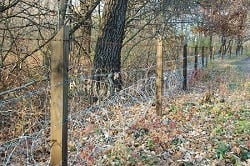
Regardless of the painstaking lengths you go to when building a structure, there are constant forces working against you, namely nature. Fences are particularly vulnerable as they rely on themselves and their stability in the ground to keep them rigid and holding. What do you do when your fence falls victim to gravitational pulls and shifts in the earth? You do your best to make it last and probably learn something about installation for the next edition. Here are a few tips to address common fence issues.
Leaning fence
Let’s say your fence fell victim to a natural disaster like we’re seeing so much of nowadays. Wet earth and high winds create movement in your posts and if you’ve not cemented them in, they’re going to sway (thus creating a back and forth motion in their post holes that loosens their support system). The first step is to secure your fence upright while you wait for the soil to dry. You can anchor the fence to large stakes or trees temporarily. Next, when your soil is ready, dig out a 4-inch trench to the bottom of each post and fill with concrete. If you’re not inclined to cement, you can also use a pressure-treated wedge to hold them, but it’s a less lasting approach.
Sagging Gate
That Mother Nature is always picking on you, in this case it’s not weather, but gravity. Fence gates tend to be heavy, and those two hinges are in an eternal battle against the constant pulling of the earth. This is such a common issue that they sell kits for it called, fittingly, “gate repair kits”. These kits feature a metal turnbuckle and lengths of galvanized wire that are installed at an angle on the gate. When installed and tightened, they bring the hanging side of the gate up to the proper height, returning it to normal operation. But know that it’s not a permanent fix and will eventually need replacing (likely the posts supporting it as well).
Rotted Fence
Nature is once again on the attack, this time in the form of moisture, mold, or insects. If you’re lucky enough to only have damage on the panels, it’s a simple remove and replace situation. Be sure to use fasteners that will last and the right tool for the job – we’re partial to the BECK Stainless Steel and SCRAIL® FasCoat®. When your rails are simply screwed to the posts, you should be able to back out the screws to detach them. For more solid fences, you’ll need to add a 2x4 under each side of the rotted post to act as a temporary support. You may also need to use a circular saw, set to a depth that will cut the post not the panel, to cut out chunks of the post to fully remove it. After you have it removed, be sure to set the new fence post with lasting materials like tamped gravel or concrete.
Build your fence right the first time.
We’ve said it before and we’ll say it again, there is nothing worse than building the same fence twice so be mindful in your construction, location, materials, and fastener choices when you’re building it the first time. The SCRAIL® FasCoat® will provide superior holding power and corrosion protection for wire applications. Used in combination with pressure-treated, quality wood, you’ll end up with a finished product that will last.
.svg.png)

